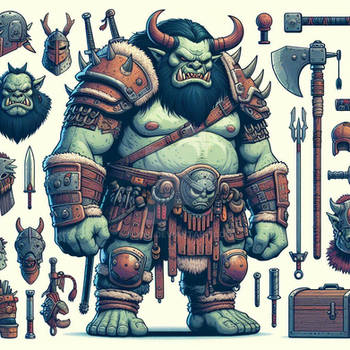ShopDreamUp AI ArtDreamUp
Deviation Actions
Celtic art is the art associated with the peoples known as Celts; those who spoke the Celtic languages in Europe from the Neolithic age through today. Celtic art is also applied to the art of ancient peoples whose language is uncertain, but have cultural and stylistic similarities with speakers of the Celtic languages.
Celtic art is a difficult term to define, covering a huge expanse of time, geography and cultures. One could make a case for artistic continuity in Europe from the Neolithic age, through the Roman Conquest and up to today. "Early Celtic art" refers to the Hallstatt period (before the 5th century BC). Art historians typically begin to talk about "Celtic art" only from the La Tène period (broadly 5th to 1st centuries BC) onwards. The Early Medieval(from 4th to 9th centuries AD) art of Britain and Ireland, which produced the Book of Kells and other masterpieces, and is what "Celtic art" evokes for much people, is called “Insular art “in the academia of art history. Insular art is considered the golden period of the Celtic art.
The Celtic art styles absorbed considerable influences from non-Celtic sources either through trade or conquest of others or of themselves, but retained a preference for geometrical decoration over figurative subjects, which are often extremely stylized. Energetic circular forms, triskeles and spirals are characteristic. When narrative scenes do appear it is usually under outside influences. Good examples of outside influences are the Gundestrup Cauldron and the book of Kells. Much of the surviving material is in precious metal, which no doubt gives a very unrepresentative picture, but apart from Pictish stones and the Insular high crosses, large monumental sculpture, even with decorative carving, is very rare.
Typically, Celtic art is ornamental, often involving complex symbolism avoiding straight lines and only occasionally using symmetry. Celtic art has used a variety of styles and has shown influences from other cultures in their knotwork, spirals, key patterns, lettering, zoomorphics, plant forms and human figures. As the archaeologist Catherine Johns put it: "Common to Celtic art over a wide chronological and geographical span is an exquisite sense of balance in the layout and development of patterns. Curvilinear forms are set out so that positive and negative, filled areas and spaces form a harmonious whole. Control and restraint were exercised in the use of surface texturing and relief. Very complex curvilinear patterns were designed to cover precisely the most awkward and irregularly shaped surfaces".
Also covered by the term is the visual art of the Celtic Revival from the 18th century to the modern era, which began as a conscious effort by Modern Celts, mostly in the British Isles and Ireland, to express self-identification and nationalism, and became popular well beyond the Celtic nations, and whose style is still current in various popular forms, from Celtic cross funerary monuments to the style self-consciously used motifs copied from works of the earlier periods, found in Folk Art and tattoos .This later style is influenced more often from the Insular than the Iron Age. Another influence was that of late La Tène "vegetal" art on the Art Nouveau movement of the late 19th Century to the early 20th Century in France.
The Halstatt Period
The Halstatt culture produced art with geometric ornament, but marked by patterns of straight lines and rectangles rather than curves; the patterning is often intricate, and fills all the space available, and at least in this respect looks forward to later Celtic styles and the probable rise of the key patterns. As Halstatt society became increasingly rich and, despite being entirely land-locked in its main zone, linked by trade to other cultures, especially in the Mediterranean, imported objects in radically different styles begin to appear, even including Chinese silks. Forms characteristic of Hallstatt culture can be found as far from the main Central European area of the culture as Ireland, but mixed with local types and styles.
Figures of animals and humans do appear, especially in works with a religious element. Among the most spectacular objects are "cult wagons" in bronze, which are large wheeled trolleys containing crowded groups of standing figures, sometimes with a large bowl mounted on a shaft at the center of the platform, probably for offerings to gods; a few examples have been found in graves. The figures are relatively simply modeled, without much success in detailed anatomical naturalism compared to cultures further south, but often achieving an impressive effect. There are also a number of single stone figures, often with a "leaf crown" — two flattish rounded projections, "resembling a pair of bloated commas", rising behind and to the side of the head, probably a sign of divinity.
Below are some examples of art from the Halstatt Period
Gundestrup cauldron; Burial wagon; Hallstatt bull; Brooch Hallstatt ; and Stone work from Halstatt





La Tène Period
About 500 BC the La Tène style, named after a site in Switzerland, appeared rather suddenly, coinciding with some kind of societal upheaval that involved a shift of the major centers in a north-westerly direction. The central area where rich sites are especially found is in northern France and western Germany, but over the next three centuries the style spread very widely, as far as Ireland, northern Italy and modern Hungary. In some places the Celts were aggressive raiders and invaders, but elsewhere the spread of Celtic material culture may have involved only small movements of people, or none at all. Early La Tène style adapted ornamental motifs from foreign cultures into something distinctly new; the complicated brew of influences including Scythian art and that of the Greeks and Etruscans among others. The occupation by the Persian Achaemenid Empire of Thrace and Macedonia around 500 BC is a factor of uncertain importance. La Tène style is "a highly stylized curvilinear art based mainly on classical vegetable and foliage motifs such as leafy palmette forms, vines, tendrils and lotus flowers together with spirals, S-scrolls, lyre and trumpet shapes".
The most lavish objects, of a society dominated by a warrior aristocracy shows this fluid art through its military equipment, even if in ceremonial versions, and containers for drink and feasting, represent most of the largest and most spectacular finds, other than jewelry.
The often spectacular art of the richest earlier Continental Celts of the La Tene period, before they were conquered by the Romans, often adopted elements of Roman, Greek and other "foreign" styles (and possibly used imported craftsmen) to decorate objects that were distinctively Celtic. A good example is the torc from the Vix Grave. This torc terminates in large balls in a way found in many others, but here the ends of the ring are formed as the paws of a lion or similar beast, without making a logical connection to the balls, and on the outside of the ring two tiny winged horses sit on finely worked plaques. The effect is impressive but somewhat incongruous compared to an equally ostentatious British torc from the Snettisham Hoard of the Insular period that is made 400 years later and uses a style that has matured and harmonized the elements making it up. The 1st century BC Gundestrup cauldron, is the largest surviving piece of European Iron Age silver, though its iconography seems clearly to be Celtic, its style is much debated, and is thought by many to be more Thracian.
A Le Tene form apparently unique to southern Britain is well illustrated by the mirror with a handle and complex decoration, mostly engraved, on the back of the bronze plate; the front side being highly polished to act as the mirror. Each of the more than 50 mirrors found has a unique design, but the essentially circular shape of the mirror presumably dictated the sophisticated abstract curvilinear motifs that dominate their decoration.
The La Tène style is not found in Ireland before some point between 350-150 BC, and until the latter date is mostly found in modern Northern Ireland, notably in a series of engraved scabbard plates. Thereafter, despite Ireland remaining outside the Roman Empire that engulfed the Continental and British Celtic cultures, Irish art is subject to continuous influence from outside, through trade and probably periodic influxes of refugees from Britain, both before and after the Roman invasion. It remains uncertain whether some of the most notable objects found from the period were made in Ireland or elsewhere. In Scotland and the western parts of Britain where the Romans and later the Anglo-Saxons were largely held back, versions of the La Tène style remained in use until it became an important component of the new Insular style that developed to meet the needs of newly Christianized populations. However, while there are fine Irish finds from the 1st and 2nd centuries, there is little or nothing in La Tène style from the 3rd and 4th centuries, a period of instability in Ireland.
Below are some examples of art from the La Tène Period
Helmet from Gaul; British hand mirror; Irish stone; Brooch; Vix torc; and Snettisham torc
.png/200px-Ceremonial_Celtic_Helmet_from_III_century_BC_Gaul_(Agris_Charente).png)





Insular Celtic Art
Celtic art in the Middle Ages was practiced by the peoples of Ireland and parts of Britain in the 700 year period from the Roman withdrawal from Britain in the 5th century, to the establishment of Romanesque art in the 12th century.
In Ireland an unbroken Celtic heritage existed from before and throughout the Roman era of Britain, which had never reached the island, though in fact Irish objects in La Tène style are very rare from the Late Roman period. The 5th to 7th centuries were a continuation of late Iron Age La Tène art, with also many signs of the Roman and Romano-British influences that had gradually penetrated there. With the arrival of Christianity, Irish art was influenced by both Mediterranean and Germanic traditions, the latter through Irish contacts with the Anglo-Saxons, creating what is called the Insular or Hiberno-Saxon style, which had its golden age in the 8th and early 9th centuries before Viking raids severely disrupted monastic life. Late in the period Scandinavian influences were added through the Vikings and mixed Norse-Gael populations, then original Celtic work came to end with the Norman invasion in 1169–1170 and the subsequent introduction of the general European Romanesque style.
The interlace patterns that are often regarded as typical of "Celtic art" were in fact introduced to Insular art from the Mediterranean, both directly and via the animal style of Germanic Migration Period , though they were taken up with great skill and enthusiasm by Celtic artists in metalwork and illuminated manuscripts. Equally, the forms used for the finest Insular art were all adopted from the Roman world: Gospel books like the Book of Kells and Book of Lindisfarne, chalices like the Ardagh Chalice and Derrynaflan Chalice, and pen annular brooches like the Tara Brooch. These works are from the period of peak achievement of Insular art, which lasted from the 7th to the 9th centuries, before the Viking attacks sharply set back cultural life.
Below are some examples of Insular Celtic Art
Book of Kells carpet page; Ardagh chalice; Irish cross; Tara brooch; and Knot work on a ring
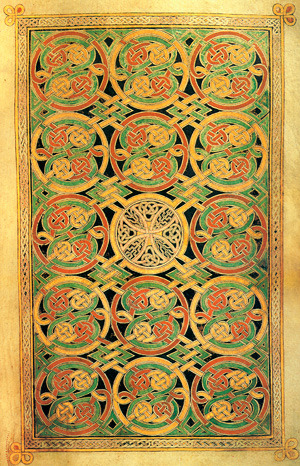

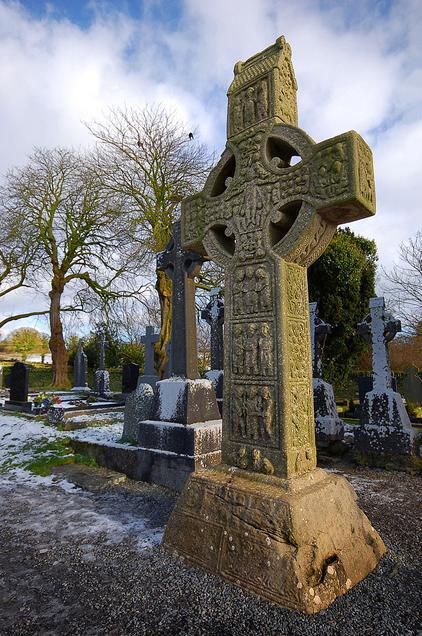


Celtic Revival
The revival of interest in Celtic visual art came some time later than the revived interest in Celtic literature. By the 1840s reproduction Celtic brooches and other forms of metalwork were fashionable, initially in Dublin, but later in Edinburgh, London and other countries. Interest was stimulated by the discovery in 1850 of the Tara Brooch. The late 19th century reintroduction of monumental Celtic crosses for graves and other memorials has arguably been the most enduring aspect of the revival, and one that has spread well outside areas and populations with a specific Celtic heritage. Interlace typically features on these, and has also been used as a style of architectural decoration, especially in America around 1900, by architects such as Louis Sullivan, and stained glass artist Thomas A. O'Shaughnessy, both men were based in Chicago, with its large Irish-American population. The "plastic style" of early Celtic art was one of the elements feeding into Art Nouveau decorative style, very consciously so in the work of designers like the Manxman Archibald Knox, who did much work for Liberty & Co..
Interlace, which is still seen as a "Celtic" form of decoration, somewhat ignoring its Germanic origins and equally prominent place in Anglo-Saxon and Scandinavian medieval art, has remained a motif in many forms of popular design, especially in Celtic countries, and above all Ireland, where it remains a national style signature. In recent decades it has been used worldwide in tattoos, and in various contexts and media in fantasy works with a quasi-Dark Ages setting.
Below are some examples of art from the Celtic Revival
Old Irish poetry; Cover art work of Yeats; Knot work; Cuff links from 1900; Silver pitcher from the 1900; and 20th Century art work


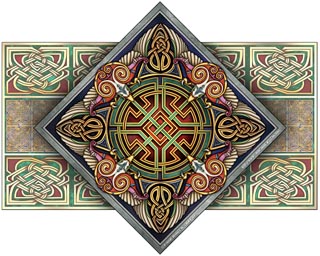
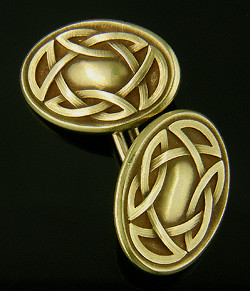


References:
- Johns, Catherine, The Jewellery of Roman Britain: Celtic and Classical Traditions, Routledge, 1996, ISBN 1-85728-566-2, ISBN 978-1-85728-566-6, Google books
- Wikipedia Celtic art
- History of Celtic Art Term essay 1982 (Mark Feighner)
With many thanks from NyanQueen to mtnboy64 for taking the time to compose this wonderful and very education paper on what exactly is “Celtic Art”. I hope the members of Celtic-Art enjoy reading it as much as I have!
PSA from a member of the review team!
Hey everybody. I wanted to make a quick info post about submitting art, and art that gets accepted or rejected.
Most of the art that you all submit gets accepted. The only criteria (at least for me, I can't speak for the other reviewers) that matters is (A) whether it is submitted to the right folder, and (B) whether the art is in some way "Celtic." It doesn't even necessarily have to be good (though I like it when it is!).
Celtic art and culture is a big category of things, and encompasses a lot of styles, symbols, etc. Having done a lot of Celtic art and research on Celtic history, I'm pretty good at recognizing wh
Holly (Tinne) Moon
Holly (Tinne) Moon
!Gewalgon-Divider1 (https://www.deviantart.com/gewalgon-divider1):icongewalgon-divider2::icongewalgon-divider3::icongewalgon-divider4::icongewalgon-divider5:
A short word from NyanQueen (https://www.deviantart.com/nyanqueen)
Greetings all!
:thumb197064994:First off, I would like to thank all members for their ongoing wonderful contributions! It really is wonderful to view all that art.
:thumb197064994:Second, in relation to submissions, I am requesting that members and contributors please pay attention to which folder they submit their art. I will include a short description of what should go in what folder at the end of this journal.
:thumb197064994:Third, I must apologize for my scarceness wit
Various Goodies
Indie Celtic Music
Please go to the youtube page for more details about the podcast, and how you can support the artists featured and the podcast itself! Many additional links are given there. Youtube page: http://www.youtube.com/watch?v=0wBOvRpivr4&feature=youtu.be&a
“Published on Apr 18, 2013
This Thursday, I'm pleased to share show #140 of the Irish & Celtic Music Podcast. It features Irish Celtic music from Duncan Ross Cameron, Kennedy's Kitchen, Allyson Adair, Naomi's Fancy, Whisky Dreams, The Bilge Pumps, Anne Roos, Neck & Neck, Amelia Hogan, Rathkeltair, Angus Mohr, Mimi Burns Band, Black 47, The Kreellers. Find out more at ht
The Renewal
Apologies!
First off, an apology to all members for neglecting my founder duties over the last few months. My internet issues persist, and to top this off I had post-grad exams to deal with in January. I do however have a short gap in which I have a few minutes to spare, and hope that I can use them to renew the life in this group (and myself) a little. Not that there appears to have been any slow down in submission activity in my absence! Wow, I have a lot of really wonderful deviations to go salivate over, and I hope to get to doing that in the next few weeks. If there were any works submitted that were not approved, please resubmit them, i
Featured in Groups
© 2013 - 2024 Celtic-Art
Comments14
Join the community to add your comment. Already a deviant? Log In
